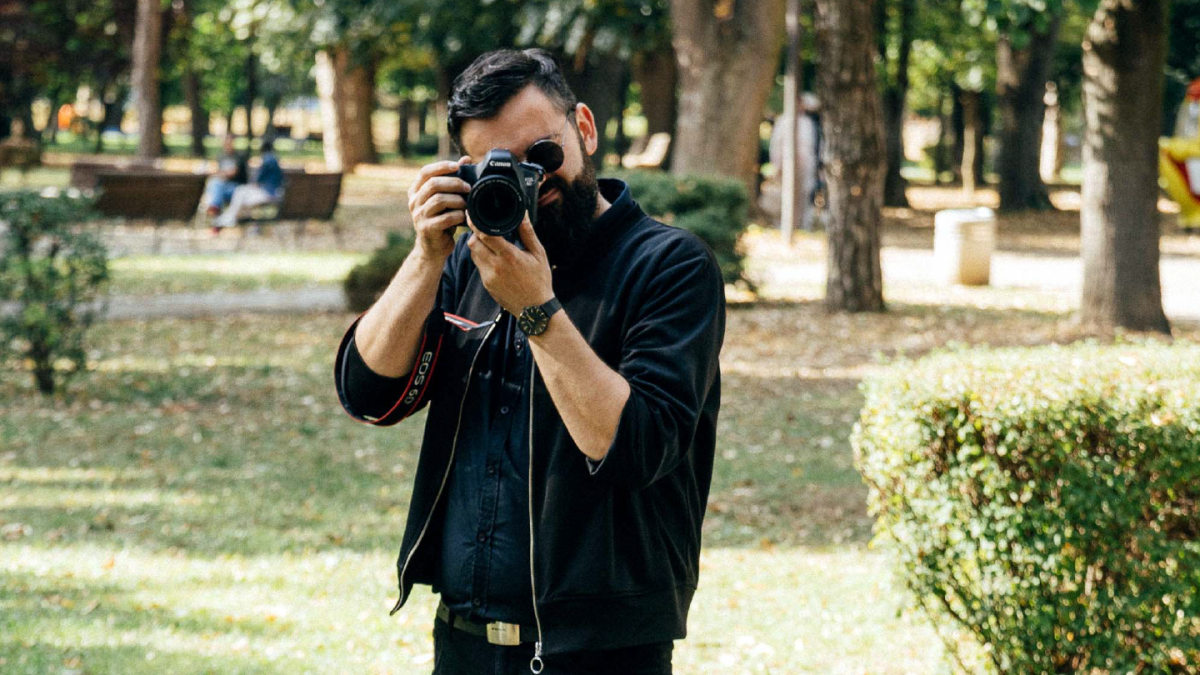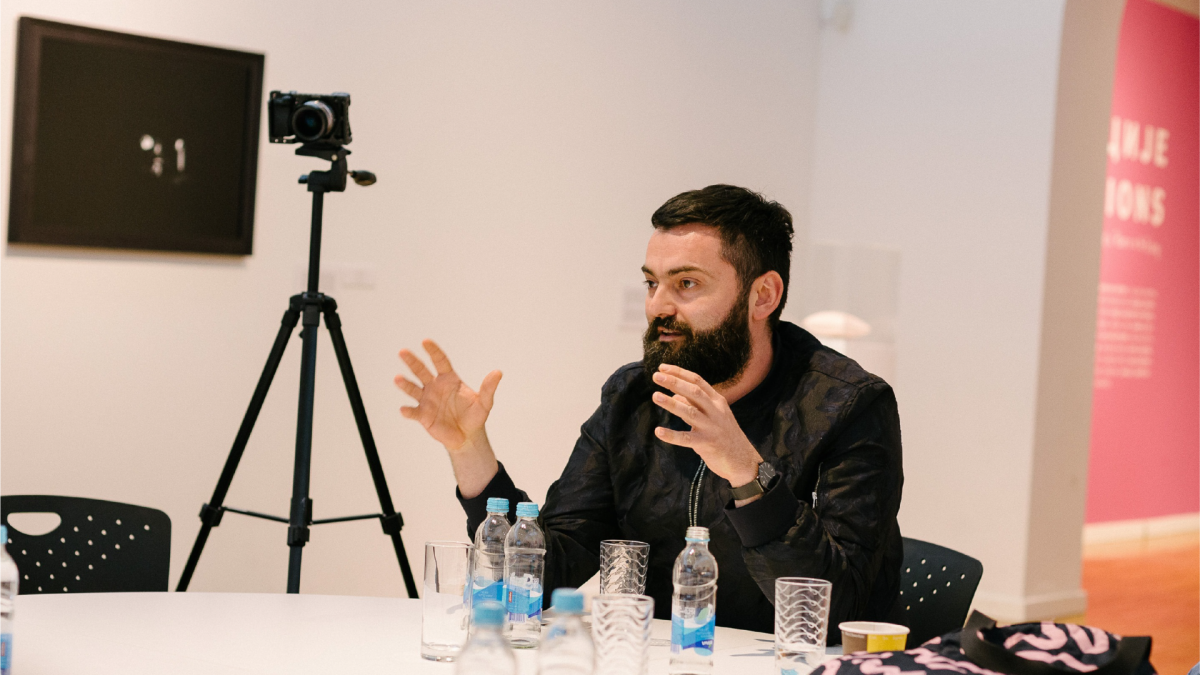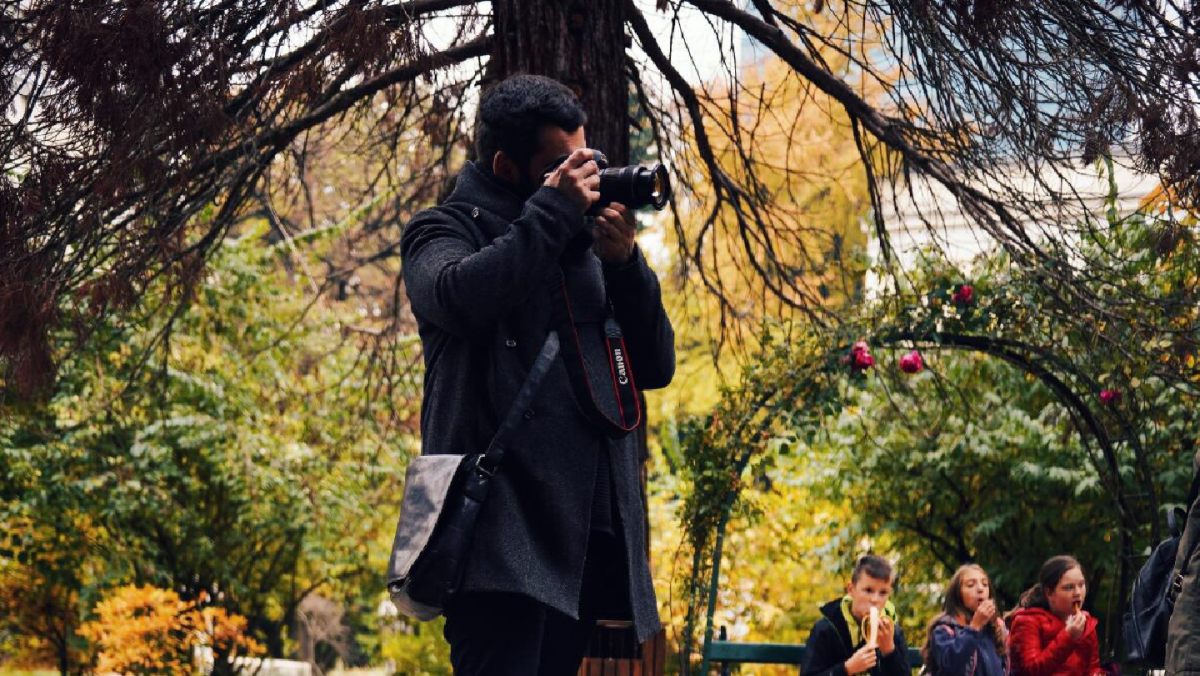He can draw the MoCARS building blindfolded and best understands the visual language of this institution. This man wears black sunglasses and a bold mustache… Should we bet he’s a fan of bold fonts? Meet Nemanja Mićević, a graphic designer who will be the first to share with you his impressions of what it’s like to be a mentor on the ReCulture project.

Good day Nemanja, and welcome to the interview column. We really appreciate finding the time to answer our questions. Accordingly, let’s start this talk by asking how much ReCulture is actually a part of your daily activities?
The initial negotiations about the ReCulture project were very exciting, and even then I saw that it was a serious and big adventure. The project is creative in itself, and as such, it is a part of my everyday life in concrete tasks that need to be solved on the one hand or re-examination of ideas on the other.
The first phase of work on identity was recently completed. What is the atmosphere in the team about that?
The first phase was very demanding. The process started with getting to know the candidates, while the team was actually built during their visit to the Museum of Contemporary Art of the Republic of Srpska. As a collective, we always tried to have a positive, working, and fun atmosphere while working on identity. Of course, this is not always easy considering the length of the project and other obligations outside the project.
How would you characterize the new identity of MoCARS that was developed as part of the ReCulture project? How does it differ from the previous one and what does it bring to the presentation of this institution?
The new identity is completely different from the previous one. The previous solution is actually just an archaic star logo for several decades and as such cannot be characterized by a visual identity if one uses the modern vocabulary of graphic design. The new identity is adapted to modern communication, which includes a complete range of recent graphic design tools based on examples of good practice from regional and international institutions. Moreover, our goal during the work on the new identity involves creating visual assumptions that would make the MoCARS identity modern, fresh and recognizable both locally and regionally. I think that Sonja and Luka made an excellent contribution in solving the tasks in this phase of the project.
What is the designer’s progress so far compared to the starting point of the work? In which segments is the progress most noticeable?
Progress is certainly noticeable in the general sense of work on the project assignment. Namely, the project assignment, the rebranding of a cultural institution is unusual in itself and it is certain that most graphic designers will not have the opportunity to do this kind of work in their career. Bearing in mind that these are young designers who do not have much experience in practical and commercial work, the progress could be felt at every subsequent meeting we had. Progress was also evident in software skills, especially in preparing presentations for EU mentors and the institution itself. They managed to create an excellent synergy between the visual templates and the narrative that explains their ideas.
What are the advantages and what are challenges of organizing a team whose members do not live in the same country?
It seems to me that today there is no need to talk about advantages and challenges in this sense. Simply put, new technologies enable constant communication that can only be disrupted by a difference in time zone. In our case, communication is continuous through the Slack and Zoom applications. Of course, direct acquaintance is certainly a plus, but not necessary in order to do the work at the assumed, high level.
What do you find the most challenging thing for you so far in working with young designers within this project?
Perhaps the most challenging thing was to maintain a high level of motivation, considering that the project was taking a long time. Annual vacations or obligations on other projects used to cause “idling”, so the return to the previous work track does not always go smoothly. Also, I noticed that after the presentations we had with the EU mentors and the MoCARS, energy can be drained. However, I think that these are all normal occurrences and I am overall satisfied with the energy that the MoCARS team has shown so far.

What characterizes your team?
The MoCARS team is characterized by a kind of complementarity. Namely, on the one hand, Luka shows an incredible gift when it comes to visual expression, and Sonja, on the other hand, a fantastic approach in creating a narrative in relation to the visual part, and finally, an excellent public presentation. Regardless of the mentioned characteristics of the candidates, Sonja and Luka also complement each other in both directions, so it can be said that the mentioned complementarity is actually the best example of teamwork.
What would you highlight as the most challenging part of working with CS institution MoCARS from the point of view of a local mentor?
The case of MoCARS is special compared to other institutions because I have been employed at the Museum as a graphic designer for 14 years. Therefore, the communication in our case was always direct, so we cannot talk about special challenges in the specific case.
Will you be able to complete the work on the rebranding of the institution in the 21 months it takes to work with the designers?
Surely. The proposed duration of the project leaves enough space to complete all project obligations. Bearing in mind that the participants in the project have other jobs that they do, this slightly longer time distance is appropriate.
Share with us your observations and tips when it comes to design as a craft. How to deal with design in the right way?
It seems to me that to deal with design, especially when it comes to craft, a constant interest in new, both in terms of trends and in software education, is necessary. Also, for high-quality design work, general education is a must so that the work can be contextualized and not just mere decoration.
Can we then say that participating in short-term or long-term open calls is a desirable experience in honing knowledge?
Definitely. In addition to practical knowledge and acquiring skills related to graphic design, candidates have the opportunity to learn about the basic principles of working in a group, and participation in a large European project is a serious experience that can be of great help in your career.
What made the applications of Sonja and Luka stand out among a large number of applications received?
From Luka’s application, one could see great potential when it comes to creative visual solutions for posters, which was crucial during the selection. Sonja’s application, according to her education in architecture, in addition to the visual aspect, also had quality in the organizational sense, i.e. the jury was drawn to the potential in terms of contextual expression. Therefore, the combination of these two candidates turned out to be a very good choice.
What little or big joys does this project bring to you personally?
It is a great joy to be part of the “ReCulture” story. Small joys are definitely teamwork and creative work and learning both from colleagues in the project and from the candidates themselves.
Your first association with MoCARS is…?
Banja Luka.
Your first association with the ReCulture project is…?
Teamwork.
We hope this conversation served as a reflection of what a great thing your small team has accomplished so far. Let this mentoring experience with Sonja and Luka be just a step forward towards what you as a team are capable of.
Thank you, mentor Nemanja!
